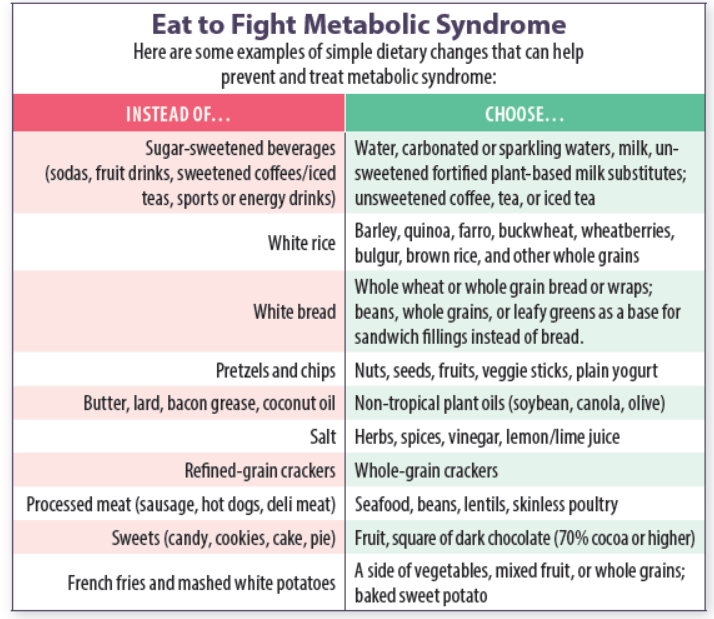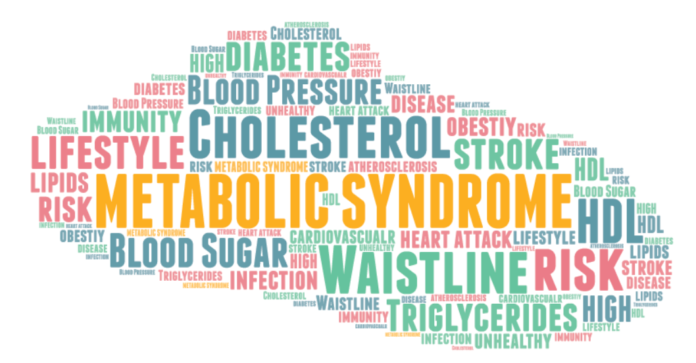Forty-four percent of U.S. adults 50 and over have metabolic syndrome, a cluster of interrelated health issues that increases risk for heart attack, stroke, and type 2 diabetes. It also raises the risk of poor immune function and severe disease due to viral infections. The good news is, metabolic syndrome can be reversed.
Metabolic Syndrome: A large waistline, high triglycerides, low HDL cholesterol, high blood pressure, and high fasting blood sugar are all part of metabolic syndrome (see Metabolic Risk Factors for more information).An astounding 88 percent of U.S. adults age 20 and older have at least one of these conditions. Each component on its own increases risk for health problems, but together, risk is even greater.
Family history, ethnicity, and age play a role in risk for developing metabolic syndrome, but diet is key. High sodium intake raises blood pressure, for example, but foods rich in refined grains, starches and sugars are perhaps the top concern, according to Dariush Mozaffarian, MD, DrPH, dean of the Friedman School and editor-in-chief of Tufts Health & Nutrition Letter. “When we overload on rapidly digested refined starches and sugars, blood sugar (glucose) spikes, leading to an array of counter-regulatory hormones that predispose to metabolic syndrome,” says Mozaffarian.
Buildup of fat around the organs in the abdomen—which shows up as a widening waistline—is harmful to metabolic health, and fat in the liver is of particular concern. “The liver is in charge of transforming excess starch and sugar into fat,” says Mozaffarian. “This newly synthesized fat is supposed to be burned as energy or go to fat cells under the skin for storage. But, when these pathways are overwhelmed by modern processed foods like soda, candy, white bread, and white rice, some of the newly made fat remains in the liver.” Fatty liver is one of the earliest underlying signs of metabolic disorder. “Fatty liver is one of the foundational causes of insulin resistance (which can lead to high blood sugar), high triglycerides, and low HDL-cholesterol levels,” Mozaffarian explains. “Blood pressure also rises with fatty liver, along with systemic inflammation, although the mechanisms behind this are not yet entirely clear.”
The five conditions described below are metabolic risk factors. You can have any one of these risk factors by itself, but they tend to occur together. If you have 3 or more of these conditions, you have metabolic syndrome:
- Waist larger than 40” for men, and 35” for women, which is also called abdominal obesity or “having an apple shape.” A large waistline means you’re at increased risk for heart disease and other health problems.
- Fasting Triglycerides over 150 (or you’re on medicine to treat high triglycerides). Triglycerides are a type of fat found in the blood.
- HDL less than 40 for men, and less than 50 for women. HDL is sometimes called “good” cholesterol because it helps remove cholesterol from your arteries. A low HDL cholesterol level raises your risk for
heart disease. - Blood pressure greater than 130 systolic and/or 85 diastolic (or you’re on medicine to treat high blood pressure). Blood pressure is the force of blood pushing against the walls of your arteries as your heart pumps blood. If this pressure rises and stays high over time, it can damage your heart and lead to plaque buildup in the arteries.
- Fasting blood sugar (glucose) greater than 100 (or you’re on medicine to treat high blood sugar/type 2 diabetes). Mildly high blood sugar may be an early sign of diabetes (often referred to as pre-diabetes).
Source: National Institutes of Health, National Heart, Lung, and Blood Institute: https://www.nhlbi.nih.gov/health-topics/metabolic-syndrome
What to Do. Measuring your waistline is a simple at-home test that can identify increased risk for metabolic syndrome. If a flexible tape measure wrapped around your middle just above the hip bones is more than 35 inches (women) or 40 inches (men), make sure you are being checked routinely for other signs of metabolic syndrome. Regular check-ups provide an opportunity for catching signals of metabolic syndrome and getting it under control. Your healthcare provider will check your blood pressure and can order blood tests for factors like blood sugar control and cholesterol and triglyceride levels.
Medications are available for treating high blood pressure, high triglycerides, and diabetes, but healthy lifestyle changes are the first line of treatment. Diet is an essential factor for treating (and avoiding) metabolic syndrome, and increasing physical activity, quitting smoking, and managing stress are also important.
If you are overweight or obese, weight loss is recommended. “While weight can be hard to change quickly, randomized controlled trials show that other core aspects of metabolic health—like blood sugar, blood cholesterol, and blood pressure—can be substantially improved within just six to eight weeks, simply by improving the quality of one’s food choices, even without any weight loss,” says Mozaffarian. He recommends cutting out refined grains, starches, and sugars and replacing them with minimally processed foods rich in fiber, vitamins, minerals, and other bioactive compounds. This means reducing intake of foods like white bread, white rice, pretzels, refined grain crackers, sweets, and soda, and replacing them with fruits, nuts, beans, whole grains, veggies, seafood, and plain yogurt.
If you already have heart disease or diabetes, these diet and other lifestyle changes can help prevent or delay subsequent problems, like heart attack, stroke, and diabetes-related complications.
“We can manage, and even reverse, metabolic syndrome,” says Mozaffarian. “Dietary changes, alone or in combination with increased physical activity, make a real difference. Even without weight loss, liver fat and belly fat can be reduced—simply by improving diet. Dietary patterns rich in minimally processed, bioactive-rich foods and unsaturated fats and low in refined carbs are a great choice,” he says. “Moderate cases could see dramatic improvement within a year. If you add physical activity and achieve some weight loss, you may completely reverse metabolic syndrome.”
Poor metabolic health is a top risk factor for negative outcomes with COVID-19. Metabolic health refers to a constellation of related conditions such as obesity, insulin resistance, type 2 diabetes, high blood pressure, inflammation, abnormal cholesterol and triglyceride levels, and abnormal vascular function.
Several of these factors (including type 2 diabetes, obesity, and high blood pressure) by themselves increase risk for hospitalization and death from this novel coronavirus by an astounding two to three times. Together, they raise risk even more. “COVID-19 is like a heat-seeking missile for poor metabolic health,” says Dariush Mozaffarian, MD, DrPH, dean of the Friedman School and editor-in-chief of Tufts Health & Nutrition Letter. “The consistency and strength of the links between metabolic diseases and COVID-19 outcomes are remarkable and highly unusual.”
“We should view COVID-19 as a fast pandemic on top of a slow pandemic—that of diabetes, obesity, and related metabolic conditions,” says Mozaffarian. “And, these pandemics are interlinked, with COVID-19 being far more severe than it would be if we had a metabolically healthier population. Although research is urgently needed to confirm that improving metabolic health will reduce COVID-19 severity, it’s very plausible.” So, while we are social distancing, wearing masks, and hand washing, we should also focus on improving our metabolic health.”
To prevent or reverse metabolic syndrome, try the following:
➧ Eat a high-quality diet: Focus on minimally processed foods rich in fiber, vitamins, minerals, and other bioactive compounds (like fruits, vegetables, legumes, and whole grains) in place of refined grains, starches, and sugars, as well as sodium and saturated fats. See the tips in the “Eat to Fight Metabolic Syndrome” box.
➧ Get moving: Increase physical activity—every little bit helps.

























